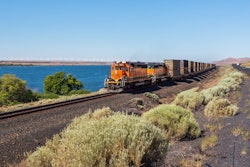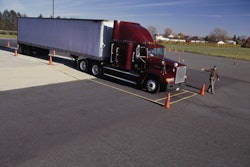There aren’t many business owners who have faced Sam Donaldson and a House subcommittee and found both experiences gratifying. Vern Garner is one of the exceptions. What’s more, the on-air exposure and experience testifying before Congress several years ago may have helped prepare Garner a little for his upcoming assignment. At the end of October, Garner is slated to become front man for the trucking industry as chairman of the American Trucking Associations.
Garner, chairman and chief executive officer of Findlay, Ohio-based Garner Transportation Group, appreciates the challenge. Known for being outspoken, Garner recognizes that coalition building requires compromise, give-and-take and choosing words carefully. He also understands how important this period is for the industry and the association.
The industry faces challenges and opportunities at every turn – a technology change in truck engines, unstable fuel prices, an important reauthorization bill, the ever-present specter of hours-of-service changes and the prospect of a renewed driver crisis as freight volumes return. And ATA itself faces changes and challenges, such as the planned transition in January from Bill Canary to Bill Graves as president, a push for more members and differences among members on issues like fuel surcharges and truck size and weight.
Keeping on truckin’
Garner believes that one of his most important jobs will be to continue some initiatives begun during the tenure of his friend David McCorkle, the current ATA chairman. “I want to continue on with the federation building and the membership drive,” Garner says.
Garner is particularly pleased with the thaw in relations between ATA and its federation partners, such as the state trucking associations and affiliated groups. “The Trucking Association Executives Council was closer together [at its July annual meeting] in Pennsylvania than it has been in years. The healing process has really been stepped up a notch or two. I want to keep that on the front burner and make sure we don’t slide backwards.” Garner credits McCorkle among others with a big success on the federation front: The Truckload Carriers Association’s and New Hampshire Trucking Association’s reaffiliation with ATA.
Kansas Gov. Bill Graves, who is slated to take the helm at ATA in January, shares a commitment to the federation, Garner says. “The governor wants to visit every state as quickly as possible.”
Just as critical as federation relations is membership, Garner says. “We have to have more members; the numbers are what the bureaucrats look at.”
But in a sense, adding members complicates ATA’s mission by diversifying interests. The truckload and less-than-truckload segments, for example, are at odds on a fuel surcharge and on weight. Many truckload carriers want a mandatory fuel surcharge, but LTL carriers see that move as opening the door to re-regulation. Meanwhile, LTL carriers generally favor increased weight limits. But most truckload van carriers cube out before they weigh out, and many don’t believe they would get more money from shippers anyway.
Garner acknowledges that such disagreements force ATA to remain silent on some big issues, but he doesn’t think they undermine ATA’s authority to speak for the industry on other issues. “ATA does a good job looking at the whole picture,” he says. Moreover, Garner believes that the association’s diversity encourages the kind of debate and compromise that lend additional credibility to ATA positions. “It’s not a rubber-stamp organization.”
Garner’s projects
Advancing membership and federation relations may be top priorities, but Garner hardly sees himself as just a caretaker. He has a few pet projects that he hopes to advance during the coming year. For example, he wants to promote a stronger relationship between the trucking industry and state highway patrols. The working relationship in Ohio is especially strong, Garner notes. Also, Garner has been involved in the efforts to implement a single state registration system, and he wants to push that issue.
Another cause for Garner is shipper-carrier relations, which he believes could be the most important issue for the industry in a few years. “We’re running out of roads, and we’re running out of drivers.” Eventually, the only solution will be for shippers and receivers to extend their hours, he says. “The restrictions of 6 a.m. to 2 p.m. – that’s going to have to end.” If shippers and receivers would change those practices, drivers could be more productive in a shorter period of time, he says. Drivers in turn would be easier to find because the hours they are paid would match more closely the hours they are away from home. Garner hopes to bring that message to the National Industrial Transportation League and other shipper/receiver groups over the next year.
Garner plans to promote ATA’s efforts toward image building, especially driving home the importance of trucking to the economy. “I really want to make sure that everyone is aware that we’re not just there to block the passing lane.”
In the end, promoting image and all the other big campaigns require one thing, Garner says. Financing. “That is one of the reasons we need more members. We have the tools, but we need the money to do it.”
Garner points to the fuel storage tank that he initially couldn’t install because the company was located beyond city water lines.
Big story from a small pond
Garner’s tale of over-regulation received national attention
Vern Garner’s biggest media exposure to date revolves around a tiny body of water and a big tank of diesel.
In May 1995, noted ABC correspondent Sam Donaldson visited Findlay, Ohio, and interviewed Garner as part of a Prime Time Live piece exposing the problem of overregulation and the often-expensive contradictions it can create for businesses. Garner also told his story to a House subcommittee in January 1995 in support of a proposed moratorium on federal regulations.
In the mid-1990s, Garner Trucking spent $85,000 to build a pond for capturing stormwater runoff from its trucks and parking areas. At first, Garner didn’t have a real problem with this requirement of the Clean Water Act because he believes that companies have a responsibility to preserve the environment. In fact, Garner Trucking had already spent $126,000 to install an oil/water separator and connect all maintenance shop and fuel island drains to it.
But then this pond, which costs $7,500 a year to maintain, flooded twice in the first 10 months, releasing any pollutants that it might have captured. EPA officials had predicted that it might flood once in 100 years. Apparently, not many pollutants are in the pond anyway. Garner stocked it with fish, reasoning that as long as the fish lived, the pollution was within an acceptable range. In the years since, not a single fish has died. The pond does serve a purpose, however. Garner allows the local volunteer fire department to use it.
At about the same time, the requirements of the Resource Conservation and Recovery Act forced Garner Trucking to choose between digging up its six underground storage tanks or installing monitoring wells and making the tanks corrosion-resistant. The latter option was far too costly, but the first option was no bargain either. So even though it turned out that none of the tanks had leaked a drop, the company paid $14,000 each for a certified contractor to dig up and dispose of the tanks.
What really bugged Garner, however, was the process for replacing those tanks. He had planned to replace the underground storage tank at his main terminal, for example, with an aboveground tank with the same capacity. A tank that large would allow Garner Trucking to continue buying fuel by the tankerload and retain his important volume discount. The company prepared for the installation by building a concrete wall around the site to contain any leak or spill.
Garner related his frustration to a House Government Reform and Oversight subcommittee. “But the state fire marshal said I couldn’t install an aboveground tank large enough to store a full tankerload because I’m four miles beyond the city water lines and supposedly didn’t have an adequate water supply – even though I had just installed a pond that the fire brigade itself finds adequate for firefighting!” Garner eventually resolved satisfactorily the dispute over the size of his aboveground storage tank – but not before his small pond became a symbol of regulation run amok.
Vern Garner with his daughters, Stephanie Garner Kramer (left) and Sherri Garner Brumbaugh, and son-in-law Joe Kramer. All hold key positions in the company.
From fertilizer to foodstuffs
Dedicated employees and a little luck helped the Garners succeed
During the 1950s, Vern Garner worked in an automotive plant in northwestern Ohio. The pay and benefits were great, but he grew tired of the endless layoffs – 14 in all. He would build a little seniority and win a promotion or two and then the next layoff would send him back to square one. Eventually, the frustration outweighed the financial attractiveness of his plum union job. So when Vern’s brother-in-law offered him a chance to join him in nearby Findlay in a business spreading lime and fertilizer, he took it.
Eventually, Vern and his wife Jean bought out her brother-in-law’s interest, and in 1960 Garner Trucking was born with one truck and some fertilizer-spreading equipment. It was hardly easy money. Compounding the inherent difficulties of fertilizer spreading as a business, the seasonality was particularly brutal. The work was done mostly during the winter. “It was tough work in the worst weather,” Vern recalls.
But Vern and Jean soon benefited from some fortuitous timing. A seaway for exporting grain had opened in Toledo, just about 45 miles to the north. Garner Trucking now had freight opportunities.
Still, times were lean during the 1960s. “We didn’t take salaries; everything we had, we put back into the business,” Vern says. “If our daughter needed shoes and a truck’s brakes needed shoes, guess who got them.” That comment always bothers Jean, but she concedes that that was how it had to be. If a truck wasn’t running, it took money right out of their pockets.
In 1970, Vern and Jean bought out another company, principally to obtain its operating authority. That transaction doubled the size of Garner Trucking’s fleet to 12 power units. Only then was Vern able to quit driving full time.
One of Garner Trucking’s biggest breaks came In 1971 when it began hauling for H.J. Heinz. It was a turning point because it gave Garner Trucking entrée into the world of steady, year-round freight. “Up to that point, everything we had done was seasonal,” Vern says.
On the strength of the Heinz account and other general commodities customers, Garner Trucking grew steadily during the 1970s and 1980s. In 1987, the company opened a terminal in Greenville, S.C. By the late 1990s, Garner Trucking had diversified its business significantly beyond transportation services. The company was now offering warehousing, cross-docking, logistics management and trailer leasing and maintenance. So a new umbrella company, Garner Transportation Group Inc., was formed in 1997 to reflect that diversity.
Today, Garner Transportation operates 85 company-owned trucks, plus 10 owner-operators, and 400 trailers in mostly regional hauls. Its customer base includes companies like Heinz, BMW, Rexam, Iam’s, Lowe’s and Kohl’s.
Jean retired from the day-to-day operation in 1995, but two of the Garners’ three daughters are officers. Stephanie Garner Kramer serves as executive vice president of finance and administration, and her husband Joe serves as president. Sherri Garner Brumbaugh is the company’s vice president of management information systems and corporate secretary.
Jean and Vern disagree on whether someone entering the industry today can thrive and build a successful trucking company. Jean believes the time commitment and endurance required to be too great and the financial hurdles too severe. But Vern is sure he could do it all over again. “I still have Jean. I still have the same Lord. And I still have the same passion.”








